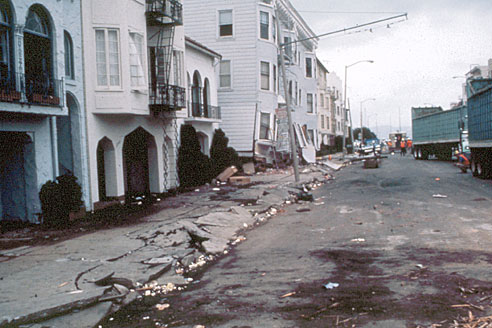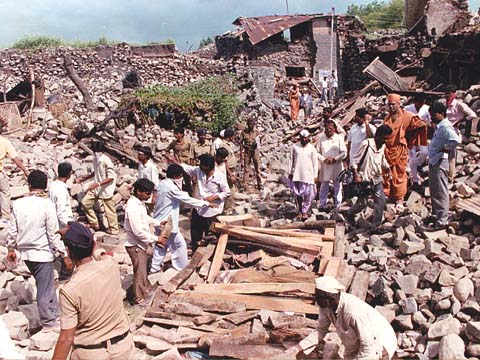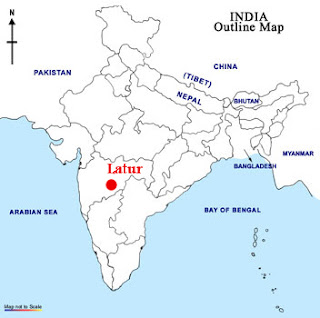The Latur,
What happened? What caused it to happen?
The Latur earthquake was one of a very rare type of earthquakes. It was what is referred to as a SCR, or a stable continental region earthquake. Most earthquakes are a result of interaction between two plates, whether they be sliding, colliding, or forming a subduction zone. (http://earthquake.usgs.gov)However, in this instance, the cause is very complicated. The Latur earthquake was an intraplate earthquake, or it occurred in the middle of a plate, as opposed to a plate boundary. The earthquake’s epicenter was very far from any fault line. The cause of this earthquake is still in speculation. Some scientists claim that it was a result of the force released from the continuous crumpling of the Indian plate against the Eurasian plate. Others claim that it was a consequence of the pressure built up as a result of the reservoir construction on the river Terna. The theory which most scientists agree on is that the many leniaments, or mini faults within plates, in that region contributed to the build up of pressure and its consequent release.(www.swaminarayan.org)
Who and what regions were affected? Why do people live in hazard prone regions?
The Latur earthquake was tremendously destructive. More than 30, 000 lives were lost. The earthquake itself didn’t cause as much damage. Most of the people were living in houses made of stones on soft soil. The tiles of the roofs were generally constructed out of stone plates, which were used as a result of availability and cost effectiveness. The tremors caused these plates to literally bury the local populace without food, water, and sometimes even air. The liquefaction, which resulted from the earthquake, destroyed the foundations of the houses and caused them to crumble. More than 60% of the deaths were a result of this.(http://www.imd.ernet.in) Liquefaction is the phenomenon that causes soft soil or sand to shake loose as a result of seismic activity. An example of liquefaction
An example of liquefaction
The people affected were mainly of the Latur and Osmanabad region and of several neighboring districts. The region itself isn’t hazard prone. As mentioned earlier, it isn’t even in close proximity to a fault or a plate boundary. An SCR earthquake occurs only about once per 100,000 years, making its predictability close to zero.(www.cessind.org)  According to scientists, it wasn’t even possible for an earthquake to strike this region, which is why there weren’t any monitoring stations in this region. However, to answer the general question, most people live in hazard prone regions for many reasons. Generally, it is a matter of livelihood. At other time, it is the case of ancestral heritage, or houses in hazard prone areas that are handed down, generation to generation. More often in LEDC’s, it is the simple fact that the people who live in hazarde prone regions cannot afford to move out to a less threatened region.(www.imd.ernet.in)
According to scientists, it wasn’t even possible for an earthquake to strike this region, which is why there weren’t any monitoring stations in this region. However, to answer the general question, most people live in hazard prone regions for many reasons. Generally, it is a matter of livelihood. At other time, it is the case of ancestral heritage, or houses in hazard prone areas that are handed down, generation to generation. More often in LEDC’s, it is the simple fact that the people who live in hazarde prone regions cannot afford to move out to a less threatened region.(www.imd.ernet.in)
What was the result? What are the effects of the hazard? How are effects different between LEDCs and MEDCs?
The remains of a 10,000 litre water tank
There were several short term and long term effects of the earthquakes. The most tragic effect was that around 30, 000 people died due to the primary and secondary hazards caused by the earthquake. The effects of this earthquake were accentuated, as the region had problems with structurally unsound buildings and the earthquake occurred at night while everyone was sleeping, giving the people less time to react.(www.swaminarayan.org) Around 30,000 people died during the seismic shaking. The remaining 20,000 were wiped out by the liquefaction that has already been mentioned. The hardest hit villages were those of the Latur and Osmanabad districts. The long term effect was that the area has still not been able to completely recover from the calamity. The earthquake has left one good mark on
What is being done about it? Possible prevention methods? Were/are there any volunteer programs to help?
people who had been trapped by the debris.



9 comments:
very nice and informtive article.. trows a lot of light on the devasting earthquake and its facts..
Keep it coming dude..
One question:
Have you published this case study as some academic project or you had an individual research on this..?
Thanks man,
Thanks for the interest. Yea, this was an academic project for my tenth grade class on the natural disaster unit.
Man, I hope my teacher likes it.
Susmit
this was very useful information to write my dissertation.thanks...!!!
good job bro..!!!
thnkzz...i needed it 4 my project...:)
Nice Article...
Very helpful for Geography A2 student, much appreciated, keep it coming my friend
How i become the part of research such formula required super computer 💻 access so how ww get super computer access 🕉🕉🕉
Post a Comment